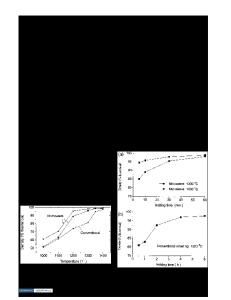In Situ Synchrotron Radiation Study of TiH 2 -6Al-4V and Ti-6Al-4V: Accelerated Alloying and Phase Transformation, and F
- PDF / 1,787,362 Bytes
- 5 Pages / 593.972 x 792 pts Page_size
- 43 Downloads / 300 Views
um hydride, normally referred to as the d-TiH2 phase [face-centred cubic (fcc) with a = 4.36 A˚], is a compound stable at room temperature (RT) but will decompose at elevated temperatures. Its transformation is dependent on atmosphere, heating rate, and powder
MING YAN, Research Fellow, is with the Centre for Additive Manufacturing, School of Aerospace, Mechanical and Manufacturing Engineering, RMIT University, Melbourne, VIC 3001, Australia, and also with the Queensland Centre for Advanced Materials Processing and Manufacturing, The University of Queensland, Brisbane, QLD 4072, Australia. Contact e-mails: [email protected], uqmyan@ gmail.com M.S. DARGUSCH, Associate Professor, is with Queensland Centre for Advanced Materials Processing and Manufacturing, The University of Queensland. C. KONG, Senior Research Officer, is with the Electron Microscopy Unit, University of New South Wales, Sydney, NSW 2052, Australia. J.A. KIMPTON, Principal Scientist, is with the Australian Synchrotron, 800 Blackburn Road, Clayton, VIC 3168, Australia. S. KOHARA, Senior Chef Scientist, is with the SPring-8/JASRI, 1-1-1 Kouto, Sayo, Hyogo 679-5198, Japan. M. BRANDT and M. QIAN, Professors, are with the Centre for Additive Manufacturing, School of Aerospace, Mechanical and Manufacturing Engineering, RMIT University. The first author of this paper had extensive discussions with Dr. Kohara during his visit to Dr. Kohara’s lab in the SPring-8 Japan Synchrotron. Dr. Kohara’s experience in synchrotron radiation has contributed a lot to the present study. Manuscript submitted July 13, 2014. Article published online October 30, 2014 METALLURGICAL AND MATERIALS TRANSACTIONS A
size (if TiH2 in present as powder), as well as temperature.[1–3] TiH2 has attracted extensive research interest for applications in hydrogen storage,[4] metal foaming,[5] and hydroprocessing.[6] In the context of powder metallurgy (PM), research on TiH2 was initiated in the 1960s[7] but recent years have seen a significant renewed interest in PM TiH2 for a few good reasons, including[8–13]: (a) the use of TiH2 powder can result in higher sintered densities and often better mechanical properties; (b) TiH2 powder can be more affordable than the hydride-dehydride (HDH) Ti powder; and (c) the use of TiH2 powder can lead to lower oxygen content in as-sintered Ti materials. This is due to the release of atomic hydrogen after heating of TiH2, which can reduce the surface oxide film on the TiH2 powder particles. As a result of these benefits, PM TiH2 shows promise as means to develop more affordable, high-performance PM titanium alloys. The dehydrogenation of TiH2 involves a number of phase transformations according to the reassessed phase diagram of Ti-H.[14] A shell of a phase was found to envelop each remaining core of titanium hydride particle.[1] This envelope of a phase not only controls the kinetics of dehydrogenation but is also expected to affect the alloying process of b-stabilizers.[1] Ivasishin and Savvakin[15] first proposed that the use of a fast heating rate could avoid t
Data Loading...











